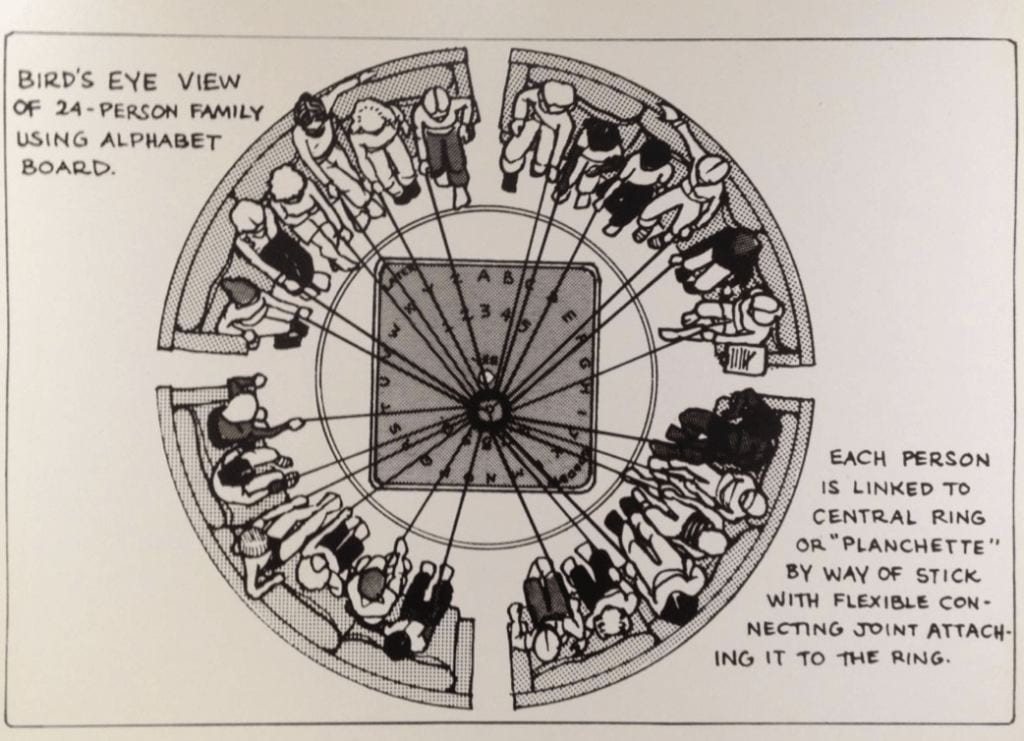Kerista’s Alphabet Board
Sylvia Hickman, WPAMC ’23
Kerista was an urban commune based in the Haight Ashbury neighborhood of San Francisco, which I had the pleasure of studying as part of a class on the material culture of America’s communal utopias. Active in its most successful iteration from 1971 to 1991, Kerista was a small group of no more than 30 people at any given time. They were most known for their practice of polyfidelity, a form of non-monogamy in which the commune was divided into groups (“Best Friend Identity Clusters,” or B-FICS), within which members were faithful to one another. They had a detailed social contract, and practiced gestalt therapy, wherein the community would come together to confront one another about perceived issues in character, neuroses, etc. Kerista was also known for their prodigious print output of newspapers, books, comics, and ephemera, particularly in the Bay Area. While theoretically a leaderless group, in practice one of their founding members, Jud, who was much older than the rest of the community, was something of a charismatic leader.
One of the more esoteric material elements of the group was their use of an “alphabet board,” very similar to a Ouija board. They had multiple alphabet boards, but all included the letters of the alphabet, numbers, and words like “yes” and “no” in a circular configuration. At least one of the boards was made by Eve, a member of Kerista and an artist who illustrated many of their publications, including comics and newspaper art.
Like a Ouija board, participants would each grasp a part of an object, in this case a cup, which would move to spell out messages and answers to questions posed, ostensibly coming from a higher intelligence. In video footage of the board being used, the cup is lifted and placed down on each letter, as opposed to being slid across the board. There is an illustration of a large group using the alphabet board, with each member holding a string tied to a central ring which would move. I am unsure if such group sessions were ever held, or simply theoretical – the footage I have seen included just two participants at a time using the board.
A 1985 Keristan publication described the alphabet board as “an important cultural artifact used for ‘telepathic information transfer through touching inspiration together’”.1 Their mythology held that the movement of the cup came from subconscious motions that were “spontaneous and totally uncontrived,” and the messages came from “morphogenetic intelligence fields,” personified as “human-like personalities” which were “the pantheon of Keristan deities.”2 As with much of Kerista’s more esoteric mythology, it is unclear how many of these ideas, which mainly came from the mind of Jud, were believed by any of the other individual members.
The alphabet board was used to answer questions, determine the “Kerista names” of members and the names of two children born to members, provide advice, and for creative works. An entire play was written through the alphabet board. It was also a useful and subversive tool in intergroup dynamics. A former member described it as being one of the more effective ways to present information or opinions to Jud, as he would accept feedback or arguments more readily from the board than directly from other members.3
According to the same 1985 publication, the alphabet board originated circa 1964 with the Kerista house in New York City, a precursor to the “New Tribe” of Kerista active in San Francisco in the 70s and 80s. According to the publication, a crudely drawn alphabet board was left by a transient stranger. Thinking it looked like a Ouija board, the members were eventually able to get it to start working, only to immediately lose money on a horse racing bet made on the board’s advice. Upon confronting the board, it reportedly demonstrated its sense of humor by saying “Schmucks, don’t use me!” Kerista’s use of the alphabet board is part of a broader tradition of spiritualism, the idea that the dead can communicate with the living. The alphabet board, like the Ouija board, is related to American traditions of spiritualism such as table tipping and seances, which were popular in the late nineteenth century. The Ouija board originated in spiritualist camps in Ohio in the 1880s, and was first named, patented, and marketed to the public in 1891. The New Age and counterculture movements of the 1960s and 70s saw a revival of spiritualism and mythology, seen in the renewed popular interest in tarot and astrology, as well as the Ouija board. In 1967, 2 million boards were sold, outselling Monopoly. Kerista was not an explicitly spiritual or religious group. Interestingly, in the face of the Christian Spiritualist tradition and the influence of Eastern religions of the period, many of the Keristans came from a Jewish background. However, their use of the alphabet board links them and their more practical utopian ideals to a broader cultural movement of the 60s and 70s.

1 Even Eve, “Glossary of Keristan English,” in KERISTA : Scientific Utopianism and the Humanities, Vol 1 Issue 4 (Spring 1985), https://www.kerista.com/kerdocs/glossary.html.
2 Even Eve, “Glossary of Keristan English.”
3 Far Out West: Inside California’s Kerista Commune, directed by Travis Chandler and Dan Greenstone (Virgil Films, 2021), https://www.amazon.com/Far-Out-West-Californias-Kerista/dp/B099CGC3CF.




Leave a Reply